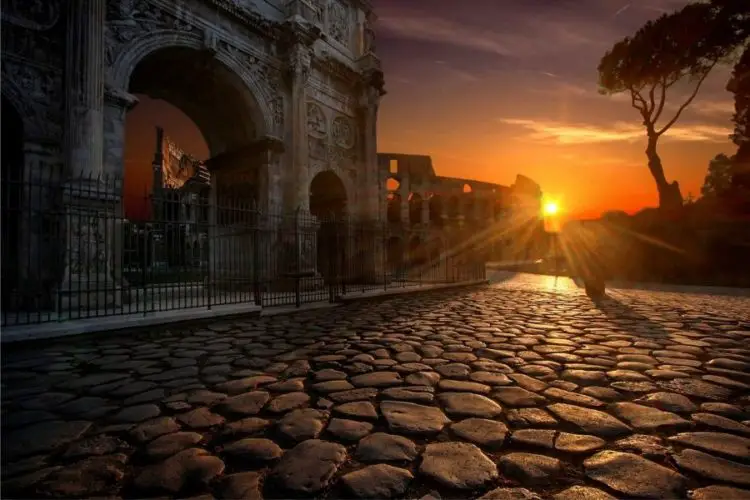The Colosseum, the largest building ever built in Rome, is an amphitheater. An amphitheater is similar to a modern theater where people watch plays, only theaters like the Colosseum were not limited to plays. In the Colosseum, people used to watch mock naval battles, gladiator games, public executions, dramas based on Roman mythology, and wild animal hunts. It was all entertainment. Later, the building was used for housing, workshops, quarters for a religious order, a Christian shrine, and as a fortress.
What makes the Colosseum different from other amphitheaters is that it is free-standing. Generally, other amphitheaters were constructed by digging into a hillside so the structure could be supported by an external sources.
History
After the tyrannical rule of the emperor Nero, Rome was still not in a better place. There was a series of misrules that ended up in a spate of civil wars. Four emperors ruled after the death of Nero, the fourth being Vespasian. Vespasian ended up ruling the 10 years from AD 69 to 79. Emperors Vespasian, Titus, and Domitian, also known as the Flavian emperors, restored senate authority and promoted public welfare. It was Vespasian’s decision to build in the place of the Golden House of Nero so that the public could enjoy it as well.
The construction of the Colosseum started around AD 70–72 under the rule of Emperor Vespasian. But the construction was completed during the rule of Vespasian’s successor and heir, Titus in AD 80. Titus officially opened the Colosseum for the people by hosting 100 days of games. Since it was an attraction of that time as well, many emperors took a fancy to it. The structure was further modified by adding the uppermost story under the rule of Emperor Domitian. These three emperors made the Colosseum the great structure we know today. The Colosseum is also known as the Flavian Amphitheater, named after the Flavian emperor.
Construction
The Colosseum is a free-standing structure, existing entirely on stone and concrete. It is a complex structure of groin vaults, measuring 620 by 513 feet overall. The Colosseum has three stories of arched entrances for a total of 80 that are supported by semi-circular columns. Each story has a different column order and style. The bottom story has a simple Doric order, the second an Ionic order, and the third an ornate Corinthian order.
The Colosseum took less than 10 years to build even though it is a large structure. There was no magic behind it, only the brains of Romans who knew their architecture. Romans knew that the arch would allow them to distribute the weight of heavy construction in the perfect manner. The arch structure is a main element in Roman architecture.
Archaeologists believe that the Colosseum contained both latrines and drinking fountains.
Shape
The Colosseum was designed in an oval form so that a large crowd could sit in it. Other amphitheaters spread across Rome have a similar structure, but the Colosseum is the largest of them all with the capacity to seat thousands of people. It could hold around 50,000 to 80,000 people at one time during various points in its history. The crowd was protected from the sun by a retractable velarium. A large tarpaulin was hung by ropes using winches, and wooden poles girded on the tops of the outer wall. Some of the amphitheaters are still in use, hosting events such as opera concerts and gladiator reenactments.
Location
The Colosseum is located east of the Palatine Hill on the grounds where Nero’s Golden House was once situated. An artificial lake was the centerpiece of the Golden House; it was drained to make way for the amphitheater. The decision to construct an amphitheater was symbolic as well as practical. By removing the private artificial lake constructed under a tyrannical emperor, Vespasian was able to build a structure where thousands of people could be seated, giving value to his people and their right to a magnificent structure they could use.
The Materials Used in the Construction
The materials used in the construction of the Colosseum were of very high quality. Limestone, tuff (volcanic rock), travertine, and brick-faced concrete were used in its construction.
Facts about the Colosseum
The Arch of Constantine is located just near the entrance of the Colosseum; it was built in honor of Constantine I’s victory over Maxentius at Pons Milvus. It was constructed in AD 315. It is possible that the seating arrangement at the Colosseum was based on social ranking. Even though the combatants who fought in the Colosseum were men, there were also female gladiators. Gladiators were slaves, war prisoners, or criminals. Wounded gladiators could plead for mercy. The crowd then decided if they would be saved or put to death. The last decision was that of the emperor; thumbs down meant death, and thumbs up meant saved. The Colosseum was actively used for four centuries but then declined by the 6th century AD. The arena’s marble seats and decorative elements were lost due to environmental factors. Restoration and preservation of the Colosseum started in the 1990s under the guidance of Pius VIII. The Colosseum attracts around seven million tourists annually. The Flavian Amphitheatre was renamed as the Colosseum due to Nero’s great statue at the entrance of the Domus Aurea. The 100 days of games hosted by Titus took the lives of more than 2,000 gladiators.
Conclusion
Even though the structure of the Colosseum has suffered ruin from earthquakes, lightning, pollution, vandalism, and stone robbers, it is still a great symbol of ancient Roman architecture. It is a great attraction of Rome with a place in the Seven Wonders of the World. Apart from being tourist attraction, the Colosseum has religious links as well. Every Good Friday, the Pope leads a torchlit “Way of the Cross” procession that takes place around the Colosseum.

